|
|
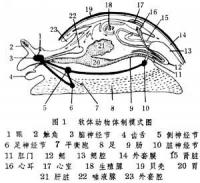 软体动物门 软体动物门
概況
軟體動物種類繁多,生活範圍極廣,海水、淡水和陸地均有産。已記載130000多種,僅次於節肢動物,為動物界的第二大門。軟體動物的結構進一步復雜,機能更趨於完善,它們具有一些與環節動物相同的特徵:次生體腔,後腎管,蠃旋式卵裂,個體發育中具有擔輪幼蟲等,因此認為軟體動物是由環節動物演化而來,朝着不很活動的生活方式較早分化出來的一支。
本門動物體外大都覆蓋有各式各樣的貝殼,故通常又稱之為貝類。由於它們大多數貝殼華麗,肉質鮮美,營養豐富,又較易捕獲,因此遠在上古漁獵時期,就已被人類利用。其中不少可供食用、藥用、農業用、工藝美術業用,也有一些種類有毒,能傳播疾病,危害農作物,損壞港灣建築及交通運輸設施,對人類有害。
主要特徵
軟體動物的形態結構變異較大,但基本結構是相同的。身體柔軟,不分節,可區分為頭、足、內臟團三部分,體外被套膜,常常分泌有貝殼。
根據軟體動物形態結構的不同,主要可以分成以下五個綱。
1.雙神經綱 左右對稱。頭部不明顯。常有貝殼八片,呈覆瓦狀排列於背面。足塊狀。如石鱉等。
2.腹足綱 左右不對稱。頭部明顯。蠃殼是蠃旋形的。足常位於腹側。如田蠃、蝸牛等。
3.掘足綱 左右對稱。頭部不明顯。足圓柱形。貝殼為牛角形的兩端開口的管。如角貝等。
4.瓣鰓綱 左右對稱。無頭部。足斧狀。有左右兩片貝殼。如河蚌、牡蠣等。
5.頭足綱 左右對稱。身體分頭和胸(內臟)兩部分。足的一部分成為條狀的碗,一部分成為漏鬥狀體。貝殼為外殼,或內殼,或無。如烏賊、鮑魚等。
◆身體的劃分
軟體動物的身體一般可分為頭、足和內臟團三個部分。
①頭部
位身體的前端。運動敏捷的種類,頭部分化明顯,其上生有眼、觸角等感覺器官,如田蠃、蝸牛及烏賊等;行動遲緩的種類頭部不發達,如石鱉;穴居或固着生活的種類,頭部已消失,如蚌類、牡蠣等。
②足部
通常位於身體的腹側,為運動器官,常因動物的生活方式不同,而形態各異。有的足部發達呈葉狀、斧狀或柱狀,可爬行或掘泥沙;有的足部退化,失去了運動功能,如扇貝等;固着生活的種類,則無足,如牡蠣;有的足已特化成腕,生於頭部,為捕食器官,如烏賊和章魚等,稱為頭足;少數種類足的側部(即側足parapodium)特化成片狀,可遊泳,稱為翼或鰭,如翼足類(pteropoda)。
③內臟團(visceral mass)
為內臟器官所在部分,常位於足的背側。多數種類的內臟因為左右對稱,但有的扭麯成蠃旋狀,失去了對稱形,如蠃類。
◆外套膜(mantle)
為身體背側皮膚褶嚮下伸展而成,常包裹整個內臟團。外套膜與內臟團之間形成的腔稱外套腔(mantle cavity)。腔內常有鰓、足以及肛門、腎孔、生植孔等開口於外套腔。
外套膜由內外兩層上皮構成,外層上皮的分泌物,能形成貝殼,內層上皮細胞具纖毛,纖毛擺動,造成水流,使水循環於外套腔內,藉以完成呼吸、排泄、攝食等。左右2片套膜在後緣處常有一二處愈合,形成出水孔(exhalant siphon)和入水孔(inhalant siphon)。有的種類出入水孔延長成管狀,伸出殼外稱為出水管和入水管。
◆貝殼(shell)
體外具貝殼為軟體動物的重要特徵,因此研究軟體動物的學科又稱貝類學(malacology)。大多數軟體動物都具有一二個或多個貝殼,形態各不相同。有的呈帽狀;蠃類為蠃旋形;掘足類為管狀;瓣鰓類為瓣狀。有些種類的貝殼退化成內殼,有的無殼。貝殼有保護柔軟身體的功能。
貝殼的成分主要是碳酸鈣和少量的殼基質(conchiolin或稱貝殼素)構成,這些物質是由外套膜上皮細胞分泌形成的。貝殼的結構一般可分為3層),最外一層為角質層(periostracum),很薄,透明,有光澤,由殼基質構成,不受酸鹼的侵蝕,可保護貝殼。中間一層為殼層(ostracum),又稱棱柱層(primatic layer)占貝殼的大部分,由角狀的方解石(cacalcite)構成。最內一層為殼底(hypostracum),即珍珠質層(peral layer),富光澤,由葉狀霰石(aragonite)構成。外層和中層為外套膜邊緣分泌形成,可隨動物的生長逐漸加大,但不增厚;內層為整個套膜分泌而成,可隨個體的生長而增加厚度。珍珠就是由珍珠質層形成的。當外套膜受到微小砂粒等異物侵人刺激,受刺激處的上皮細胞即以異物為核,陷入外套膜的上皮之間結締組織中,陷入的上皮細胞自行分裂形成珍珠囊,囊即分泌珍珠質,層復一層地將核包位逐漸形成珍珠。據史料記載公元前2200多年,我國就有淡水育珠的記載(書經.禹貢篇),廣西合浦育珠自古就很有名,采摘開始於漢代。
角質層和棱柱層的生長非連續不斷的,由於食物、溫度度等因素影響外套膜分泌機能,故貝殼的生長速度是不同的,因此在貝殼表面形成了生長綫,表示出生長的快慢。
◆消化係統
軟體動物的消化管發達,少數寄生種類(內寄蠃entocolax)退化。多數種類口腔內具顎片(mandible)和齒舌(radula),顎片一個或成對,可輔助捕食。齒舌是軟體動物特有的器官,位口腔底部的舌突起(odontophore)表面,由橫列的角質齒組成,似挫刀狀。攝食時以齒舌作前後伸縮運動颳取食物。齒舌上小齒的形狀和數目,在不同種類間各異,為鑒定種類的重要特徵之一。小齒組成橫排,許多排小齒構成齒舌。每一橫排有中央齒一個,左右側齒一或數對,邊緣有緣齒一對或多對。齒舌上小齒的排列以齒式表示如中國圓田蠃(cipangopaludina chinensis)的齒式為2.1.1.1.2。
◆體腔和循環係統
軟體動物的次生體腔極度退化,殘留圍心腔(pericardinal cavity)及生殖腺和排泄器官的內腔。初生體腔則存在於各組織器官的間隙,內有血液流動,形成血竇(blood sinus)。
循環係統由心髒、血管、血竇及血液組成。心髒一般位內臟團背側圍心腔內,由心耳和心室構成。心室一個,壁厚,能博動,為血循環的動力;心耳一個或成對,常與鰓的數目一致。心耳與心室間有辯膜,防止血液逆流。血管分化為動脈和靜脈。血液自心室經動脈,進入身體各部分,後匯入血竇,由靜脈回到心耳,故軟體動物為開管式循環。一些快速遊泳的種類,則為閉管式循環。血液無色,內含有變形蟲狀細胞。有些種類血漿中含有血紅蛋白(haemoglobin)或血青蛋白(haemocyanin),故血液呈紅色或青色。
◆呼吸器官
水生種類用鰓呼吸,鰓為外套腔內面的上皮伸展形成,位腔內。鰓的形態各異,鰓軸兩側均生有鰓絲,呈羽狀,稱盾鰓;僅鰓軸一側生有鰓絲,呈梳狀,稱櫛鰓(ctenidium);有的鰓成瓣狀,稱瓣鰓(lamellibranch);有些種類的鰓延長成絲狀。稱絲鰓(filibranch)。有的本鰓消失,又在背側皮膚表面生出次生鰓(secondary branchium),也有的種類無鰓。鰓成對或為單個,數目不一,少則一個或一對,多則可達幾十對。陸地生活的種類均無鰓。其外套腔內部一定區域的微細血管密集成同形成肺,可直接攝取空氣中的氧。這是對陸地生活的一種適應性。
◆排泄器官
軟體動物的排泄器官基本上是後腎管,其數目一般與鰓的數目一致,衹有少數種類的幼體為原腎管。後腎管由腺質部分和管狀部分組成,腺質部分富血管,腎口具纖毛,開口於圍心腔;管狀部分為薄壁的管子,內壁具纖毛,腎孔開口於外套腔。後腎管不僅可排除因心髒中的代謝産物,也可排除血液中的代謝産物。另外圍心髒內壁上的圍心髒腺,微血管密佈,可排除代謝産物於圍心髒內,由後腎管排出體外。
◆神經係統
原始種類的神經係統無神經節的分化,僅有圍咽神經環及嚮體後伸出的一對足神經索(pedal cord)和一對側神經索(pleural cord)。較高等的種類主要有 4對神經節,各神經節間有神經相連。腦神經節(cerebral ganglion)位食管背側,發出神經至頭部及體前部,司感覺;足神經節(pedal ganglion位足的前部,伸出神經至足部,司運動和感覺;側神經節(peural ganglion)發出神經至外套膜及鰓等;髒神經節(visceral ganglion)發出神經至各內臟器官。這些神經節有趨於集中之勢,有的種類的主要神經節集中在一起形成腦,外有軟骨包圍,如頭足類。軟體動物已分化出觸角、眼、嗅檢器及平衡囊等感覺器官,感覺靈敏。
◆生殖和發育
軟體動物大多數為雌雄異體,不少種類雌雄異形;也有一些為雌雄同體。卵裂形式多為完全不均等卵裂,許多屬蠃旋型。少數為不完全卵裂。個體發育中經擔輪幼蟲和面盤幼蟲(veliger larva)兩期幼蟲,擔輪幼蟲的形態與環節動物多毛類的幼蟲近似,面盤幼蟲發育早期背側有外套的原基,且分泌外殼,腹側有足的原基,口前纖毛環發育成緣膜(velum)或稱面盤。也有的種類為直接發育。淡水蚌類有特殊的鈎介幼蟲(glochidium)。
分類
依據它們的貝殼、足、鰓、神經及發生特點等特徵,分為七個綱。
◆單板綱(monoplacomphora)
絶大多數為化石種,已絶滅了近4億年。這類動物有一個帽狀或匙形的貝殼,有2~8對對稱的肌痕。1952年丹麥海洋研究船在太平洋沿岸哥斯達黎加3570m深海處第一次采得生活標本,1957年被定名為新碟貝(neopilina galathea lemche),以後又在大西洋、印度洋等處發現了一些種類。
新碟貝是一類原始的貝類,體為兩側對稱,具一近圓形而扁的貝殼,腹足強大,周緣肌肉發達,中央簿,故無吸附能力,僅適於在海底滑行。縮足肌8對,分節排列於足的周圍。足四周為外套溝,兩側共有鰓5或6對。足前端為口,後端為肛門。口前有一對具纖毛的口蓋(velum),口後有扇狀觸手一對。心髒位圍心腔內,由一心室及2對心耳構成;腎6或7對;雌雄異體,生殖腺2對,有生殖導管開口於腎,生殖細胞由腎排出體外。神經係統由圍食道神經環及嚮後伸出的側神經和足神經組成。
這類被稱為活化石的原始貝類的發現,對研究貝類的起源與演化提供了新的資料。
◆無板綱(aplacophora)
為軟體動物中的原始種類,體呈蠕蟲狀.細長或短粗,無貝殼。體表被具石灰質細棘的角質外皮,頭小,口在前端腹側,軀體細長,腹側中央有一腹溝,有的種類溝中有一小形其纖毛的足,有運動功能.體後有排泄腔,多數種類在腔內有一對鰓,腔後為肛門、無板類無觸角、眼等感覺器官:腸為直管狀,齒舌有或無;心髒為一心室一心耳,血管係統退化,雌雄同體或異體,個體發生中有擔輪幼蟲期。
無板類約有200多種,生活在低潮綫下數10m至深海海底,肉食性分佈遍及全球。我國南海海域79m深處曾采得竜女簪一種。
◆多板綱(polyplacophora)
全部生活在沿海潮間帶,常以足吸附於岩石或藻類上。體呈橢圓形,背稍隆,腹平。背側具八塊石灰質貝殼,多是覆瓦狀排列、前面一塊半月形,稱頭板(cephalic plate),中間 6塊結構一致、稱中間板(intermediate plate),未塊為元寶狀,稱尾板(tail plate)。各板間可前後抽拉移動,因此動物脫離岩石後,可以麯捲起來。貝殼周圍有一圈外套膜,稱環帶(girdle), 其上叢生有小針、小棘等,形態各異、頭部不發達,位腹側前方,圓柱狀,有一嚮下的短吻,吻中央為口。足寬大,吸附力強,在岩石表面可緩慢爬行。足四周與外套之間有一狹溝,即外套溝,在溝的兩側各有一列盾鰓,六對或數十對。
多板類約有1000種,我國沿海習貝種類有毛膚石鱉體型較大,環帶上有成叢的白色針束;鱗帶石鱉殼片高,頭板具放射肋。
◆腹足綱(gastropoda)
軟體動物中最大的一類,有10萬種以上。生活在海洋、淡水及陸地,分佈遍及全球,少數種類為寄生(內寄蠃entocolax、光蠃melanella、內殼蠃entoconcha等)。
◆掘足綱(scaphopoda)
全海産。具長圓錐形稍彎麯的管狀貝殼,如象牙狀。粗的一端為前端,開口大。稱為頭足孔;細的一端為後端,開口小,稱為肛門孔。殼凹的一面為背側,凸的一面為腹側。外套膜呈管狀,前後端有開口。頭部不明顯,前端具有不能伸縮的吻,吻基部兩側生有許多頭絲(captacula),能伸縮,末端膨大。頭絲可伸出殼外,有觸覺功能,也可攝食。掘足類為肉食性,吻內為口球,具顎片和齒舌。足在吻的基部之後,柱狀,末端三葉狀或盤狀。足可伸得很長,能挖掘泥沙。肛門開口於足的基部腹側。無鰓,以外套膜進行氣體交換。循環器官心髒一室無心耳,未分化出血管,僅有血竇。腎一對,囊狀,位胃側面。雌雄異體,生殖腺一個;個體發生中有擔輪幼蟲和面盤幼蟲。
掘足類自潮間帶至4000m深海都有分佈,約300種僅2科。角貝殼呈象牙狀,足圓錐形,末端有二冀狀側葉。本綱動物在我國分佈廣,種類多。
◆瓣鰓綱(lamellibranchia)
瓣鰓綱動物全部生活在水中,大部分海産,少數在淡水,極少數為寄生(內寄蛤entovalva、戀蛤peregrinamor等)。約有2萬種,分佈很廣。一般運動緩慢,有的潛居泥沙中,有的固着生活,也有的鑿石或鑿木而棲。
◆頭足綱(cephalopoda)
頭足類全海産,肉食性。體左右對稱,分頭、足、軀幹三部分。頭部發達,兩側有一對發達的眼,原始種類具外殼,多數為內殼或無殼;足着生於頭部,特化成腕和漏鬥,故稱頭足類。漏鬥位於頭腹面、頭與軀幹之間。羽狀鰓一對或2對,心耳和腎的數目與鰓一致。具軟骨。口腔有顎片和齒舌。神經係統集中,感官發達。閉管式循環係統。直接發生。
頭足類的生活種類約有700種化石種類在10000種以上。
係統發展
軟體動物的海産種類個體發生中為蠃旋型卵裂,且具有擔輪幼蟲,排泄器官為後腎管,這些特點均與環節動物尤其是多毛類近似。故有理由認為軟體動物和環節動物在係統發生中有着共同的起源,在長期進化中,朝着不活動的生活方式發展,因而體節消失,産生了貝殼,運動器官和神經感官均趨於退化。軟體動物中單極綱、無板綱及多板綱較為原始,這幾類的次生體腔發達,近似梯式神經;有的體呈蠕蟲形,無殼,許多器官如鰓、腎、外殼等顯不出分節排列現象。這些原始性狀的存在認為它們接近軟體動物的原始祖先,各自獨立發展一支。
腹足類較為原始,其生活方式活躍,頭部發達。瓣鰓綱生活方式不活動無頭,但原始種類具盾鰓,足部具趾面,這與腹足綱接近。掘足綱頭不明顯,套膜在胚胎時為2片,後纔愈合呈筒狀,成對的腎,腦神經節與側神經節分開,這些表明接近於原始的瓣鰓類、但掘足類無鰓,無心髒,貝殼筒形,又顯示與其他綱動物在演化上較為疏遠,可能是較早分出的一支。頭足綱為一古老的類群,起源早,化石種類多。它們生殖腔與體腔相通,似無板綱;個體發生中在胚胎早期無腎,似多板綱和無板綱;生殖導管來源於體腔導管又似多板綱。由於頭足類其有原始軟體動物的特點說明它們與軟體動物的原始種類接近。但頭足類有機結構,復雜神經係統高度集中,且為軟骨質包圍;眼的結構似脊椎動物,基本為閉管式循環係統;直接發生,無幼蟲期。由於頭足類既有原始性狀,又有高度的進化特徵,故推測它們可能很早分出的一支,沿着更為活躍的生活方式發展的一個獨立的分支。
與人類的關係
◆價值
①食用價值
海産的鮑、玉蠃、香蠃、紅蠃、東風蠃、泥蠃、蚶、貽貝、扇貝、江珧、牡蠣、文蛤、蛤仔、蛤蜊、蟶、烏賊、槍烏賊、章魚,淡水産的田蠃、蠃螄、蚌、蜆,陸地棲息的蝸牛等肉味鮮美,具有很高的營養價值。
②藥用價值
鮑的貝殼(中藥稱石决明),寶貝的貝殼叫海巴,珍珠、烏賊的貝殼叫海螵蛸,以及蚶、牡蠣、文蛤、青蛤等的貝殼等都是中藥的常用藥材。從鮑魚、鳳蠃、海蝸牛、蛤、牡蠣、烏賊等可以提取抗生素和抗腫瘤藥物。
③農業價值
産量多的小型軟體動物可以做農田肥料或飼料,河蜆可以飼養淡水魚類。④工業用。軟體動物的貝殼是燒石灰的良好原料。珍珠層較厚的貝殼( 如蚌、馬蹄蠃等 )是製紐扣的原料 。
④工藝用或裝飾
很多貝類的貝殼有獨特的形狀和花紋,富有光澤,絢麗多彩,是古今中外人士喜歡搜集的玩賞品。
⑤地質價值
軟體動物門在地質歷史時期中有很多可作為指示沉積環境的指相化石。在世界和中國寒武係的最底部,已有單板綱和其他軟體動物化石出現,中生界的不少菊石成為洲際範圍內劃分、對比地層的帶化石,有些可用以瞭解古水域溫度和含????度等;蝸牛化石能反映第四紀氣候環境。
◆對人類的危害
陸生的蝸牛、蛞蝓等吃植物的葉、芽,危害蔬菜、果樹、煙草等;海洋中的一些肉食性種類,能殺害牡蠣、泥蚶等的幼苗,造成養殖雙殼類的損失;一些草食性種類常吃海帶、紫菜的幼苗,是藻類養殖的敵害。在淡水和陸生的軟體動物中,椎實蠃是肝片吸蟲的中間宿主,豆蠃是華枝睾吸蟲的中間宿主,扁捲蠃是薑片蟲的中間宿主,短溝蜷是肺吸蟲的中間宿主,釘蠃是日本血吸蟲的中間宿主,對人類的危害十分嚴重。海洋中的船蛆、海筍等是專門穿鑿木材或岩石穴居的種類,對於海洋中的木船、木樁和海港的木、石建築都有危害。營附着或固着生活的種類常大量附着在船底,可以影響船衹的航行速度。有些附着生活的種類,可以堵塞水管,影響生産。 |
|
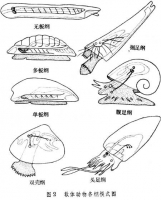 软体动物门 概述 软体动物门 概述 |
|
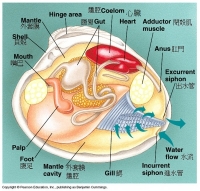 软体动物门 结构特征 软体动物门 结构特征 软体动物门 结构特征 软体动物门 结构特征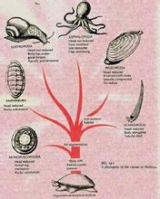 软体动物门 结构特征 软体动物门 结构特征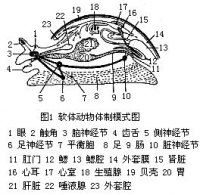 软体动物门 结构特征 软体动物门 结构特征
2、足部:是位於身體腹側的運動器官,隨生活方式不同呈現不同形式:有的種類足部蹠面平滑,適於在陸地或水底爬行,如腹足綱;有的種類足部呈斧刃狀,有利於挖掘泥沙,如瓣鰓綱;有些固着生活的種類足退化,如牡蠣科;也有些種類足部萎縮,失去了運動功能,但有足絲腺,能分泌足絲,用以附着在外物上生活,如貽貝科、扇貝科等。在頭足綱,足生於頭部,有的特化成腕,上面生有許多吸盤,為捕食器官,並有一部分變態成漏鬥,適於遊泳生活,如烏賊和章魚等。少數種類足的側部(即側足,parapodium)特化成片狀,可遊泳,稱為翼或鰭,如翼足目(Pteropoda)。足部通常生有平衡器,有些種類在足的上部生有許多觸手。
3、內臟囊:位於身體背部,包括胃、腸、消化腺、心髒、腎髒、生殖腺等內臟器官,為外套膜和貝殼所包被。多數種類的內臟囊為左右對稱,但有的扭麯成蠃旋狀,失去了對稱形,如蠃類。
4、外套膜:是身體背部皮膚皺褶嚮腹面延伸面形成的一種保護器官,由內、外表皮、中間的結締組織和少數肌肉纖維組成。外套膜與內臟之間有外套腔,外套腔內有鰓和口、肛門、腎髒、生殖腺的開口。外套膜的邊緣構造很復雜,常具各種形狀的觸手,有的種類有外套眼。外套膜內表皮細胞具纖毛,纖毛擺動,造成水流,使水循環於外套腔內,藉以完成呼吸、排泄、攝食等。左右2片套膜在後緣處常有一二處愈合,形成出水孔(exhalant siphon)和入水孔(Inhalant siphon)。有的種類出入水孔延長成管狀,伸出殼外稱為出水管和入水管。
5、貝殼:體外具貝殼為軟體動物的重要特徵,因此研究軟體動物的學科又稱貝類學(Malacology)。貝殼由外套膜分泌的鈣質和有機質形成。大多數種類有1扇貝殼,如腹足綱、掘足綱,也有不少種類有2扇貝殼,如瓣鰓綱,很少數種類有8扇貝殼,如多板綱;也有一些種類貝殼退化成內殼,有的無殼。貝殼的形態隨種類變化很大,有的呈帽狀;蠃類為蠃旋形;掘足綱為管狀;瓣鰓綱為瓣狀,這是區分種類的重要特徵之一。
貝殼的成分主要是碳酸鈣和少量的殼基質(conchiolin,或稱貝殼素)構成。貝殼的結構一般可分為3層:最外一層為角質層(periostracum),很薄,透明,有光澤,由殼基質構成,不受酸鹼的侵蝕,可保護貝殼;中間一層為殼質層(ostracum,又稱棱柱層,primatic layer),占貝殼的大部分,由角柱狀的方解石構成;最內一層為殼底(hypostracum,即珍珠質層,peral layer),富光澤,由葉狀霰石(aragonite)構成。外層和中層為外套膜邊緣分泌形成,可隨動物的生長逐漸加大,但不增厚;內層為整個套膜分泌而成,可隨個體的生長而增加厚度。珍珠就是由珍珠質層形成的。當外套膜受到微小砂粒等異物侵人刺激,受刺激處的上皮細胞即以異物為核,陷入外套膜的上皮之間結締組織中,陷入的上皮細胞自行分裂形成珍珠囊,囊即分泌珍珠質,層復一層地將核包位逐漸形成珍珠。據史料記載公元前2200多年,我國就有淡水育珠的記載(《書經·禹貢篇》),廣西合浦育珠自古就很有名,采摘開始於漢代。角質層和殼質層的生長非連續不斷的,由於食物、溫度等因素影響外套膜分泌機能,故貝殼的生長速度是不同的,因此在貝殼表面形成了生長綫,表示出生長的快慢。 |
|
神經係統
軟體動物中,原始種類的神經係統無神經節的分化,僅有圍咽神經環及嚮體後伸出的一對足神經索(pedal cord)和一對側神經索(pleural cord);較高等種類的神經係統由4對神經節和與之聯絡的神經構成:腦神經節(cerebral ganglion)1對,位於食道背側,派出神經至頭部和體前部,司感覺;足神經節(pedal ganglion)1對,位於足的前部,派出神經至足部,司運動和感覺;側神經節(peural ganglion)1對,位於體前部,派出神經至外套膜和鰓等;髒神經節(visceral ganglion)1對,位於體後部,派出神經至內臟諸器官。各對神經節之間有橫的神經聯合,各不同神經節之間亦有神經連索,這些神經節的排列和神經聯合以及神經聯索的長短隨類別不同而異。原始的種類沒有顯明的神經節,神經係統主要由圍繞食道的環狀神經中樞和由它派生的2對神經索構成,如單板綱。在腹足綱、瓣鰓綱和掘足綱等較進化的種類,神經節分化明顯;而在高等的頭足綱,各神經節均集中在頭部形成腦,外有軟骨包圍。
感覺器官
軟體動物已分化出觸角、眼、嗅檢器及平衡囊等感覺器官,感覺靈敏。觸角的數目和形狀各類不同:新碟貝有2個口前小觸角;腹足綱前鰓亞綱有1對頭觸角;肺蠃亞綱有2對觸角,其中1對大觸角起嗅覺作用。後鰓亞綱的嗅角、頭足綱的嗅覺陷,都與肺蠃亞綱的大觸角相似。在瓣鰓綱,外套膜邊緣、水管觸手都有感覺細胞起觸覺作用。
1、眼:軟體動物眼的構造,從最簡單的色素凹陷直到復雜的具晶體和網膜結構的都有。眼通常1對,位於頭部兩側,有的生於觸角頂端。頭部不發達或頭部退化的類群無頭眼,但石鱉類的貝殼表面有微眼,瓣鰓綱很多種類有外套眼。
2、平衡囊:除雙神經類外,其他類群都有平衡囊,位於足部,左右各1個,由足部皮膚內陷而形成。原始的種類囊內具耳沙,演化的種類則具耳石,在耳沙或耳石的刺激下,動物能測定行動的方向和保持身體的平衡。平衡囊受腦神經節的控製。
3、嗅檢器:是水生軟體動物用來檢驗水流中沉積物質量和水的化學性質的器官,受腦神經節派出的神經控製。
消化係統
軟體動物的消化係統包括口、食道、胃、腸、肛門和附屬的腺體。口為一簡單的開口或具較發達的肌肉。瓣鰓綱口的周圍有發達的唇瓣;頭足綱有口膜;除瓣鰓綱外,口腔內均有顎片(mandible)和齒舌(radula)。在腹足綱,或是僅有1個顎片位於背面,或是有2個位於口腔兩側,在頭足綱,有2個顎片分別位於口腔的背腹面,顎片可輔助捕食。齒舌是軟體動物特有的器官,位於口腔底部的舌突起(odontophore)表面,由排列成行的角質齒構成,似挫刀狀。攝食時以齒舌作前後伸縮運動颳取食物。齒舌的形態,包括小齒的形狀、數目和排列方式因類而異,為區分科屬的依據之一。小齒組成橫排,許多排小齒構成齒舌。每一橫排有中央齒一個,左右側齒一或數對,邊緣有緣齒一對或多對。齒舌上小齒的排列以齒式表示,如中國圓田蠃(Cipangopaludina chinensis)的齒式為2.1.1.1.2。口腔內有唾液腺的開口,口腔嚮下為食道,食道常形成嗉囊。食道也有附屬腺體,如腹足類的勒布靈腺、毒腺等。食道嚮下為胃,胃通常為一花卵形口袋,其內壁有強有力的收縮肌。在腹足綱的被鰓亞目中,有些種類的胃壁生有咀嚼板。在裸鰓亞目中,有的種類具成行的幾個質齒。在瓣鰓綱的胃中,常有1個幽門盲囊,其中有晶桿。胃內有主要消化腺肝髒的開口。胃的後部為腸,胃腸之間常有1個瓣膜分開。腸的末端為直腸,有的種類在直腸內有附屬的肛門的開口。軟體動物的消化管發達,少數寄生種類(內寄蠃,Entocolax)退化。
呼吸係統
水生軟體動物用鰓呼吸。鰓是由外套膜內面的上皮伸展形成的。鰓的形態各異,包括鰓軸和鰓絲。有的種類鰓軸兩側均生有鰓絲,呈羽狀,稱盾鰓;有的種類僅鰓軸一側生有鰓絲,呈梳狀,稱櫛鰓(ctenidium);有的鰓成瓣狀,稱瓣鰓(lamellibranch);有些種類的鰓延長成絲狀。稱絲鰓(filibranch)。有的本鰓消失,又在背側皮膚表面生出次生鰓(secondary branchium),也有的種類無鰓。鰓軸與動脈和靜脈貫通,通過鰓的污濁血液即進行氣體交換。鰓的數目和形態隨類別而異,成對或為單個,在單板綱為5或6對,多板綱為6~88對,原始的腹足類為1對,較高級的種類為1個,瓣鰓綱為1對,頭足綱為2對或1對。陸生軟體動物均無鰓,在外套腔內部一定區域形成微細血管密集的肺室,可直接攝取空氣中的氧。這是對陸地生活的一種適應性。
循環係統
循環係統由心髒、血管、血竇(blood sinus)及血液組成。循環係統的中樞為心髒,心髒位於身體背部的圍心腔(pericardinal cavity)中,有一個心室和根據類別不同有1個、2個或4個心耳。心室壁厚,能博動,為血循環的動力;心耳常與鰓的數目一致。心耳與心室間有瓣膜,防止血液逆流。血管分化為動脈和靜脈。血液自心室經動脈,進入身體各部分,後匯入血竇,由靜脈回到心耳,故軟體動物的循環係統一般為開管式循環,但在較高等的頭足綱,動脈管和靜脈管內的微血管聯絡成為閉管式循環。血液無色,內含有變形蟲狀細胞。血液中一般含血清素,血液呈青色。僅瓣鰓綱中的蚶和腹足綱的扁捲蠃科有血紅素,血液呈紅色。軟體動物的次生體腔極度退化,殘留圍心腔及生殖腺和排泄器官的內腔。初生體腔則存在於各組織器官的間隙,內有血液流動,形成血竇。
排泄係統
軟體動物的腎髒呈囊狀,由具纖毛的腎管形成,腎管的一端與圍心腔相通,另一端在外套腔中開口,不僅輸送集於圍心腔中的廢物,而且能濾出血液中的廢物一並排出體外。腎髒在單板綱為6對;在多板綱、瓣鰓綱、原始腹足綱以及頭足綱的二鰓類為1對;在四鰓類為2對;高等的腹足綱衹有1個。除腎髒外,腹足綱、瓣鰓綱和頭足綱的許多種類的圍心腔壁上的腺體亦有排泄作用。腹足綱後鰓亞綱的肝髒的一部分也是重要的排泄器官。
軟體動物的排泄器官基本上是後腎管,其數目一般與鰓的數目一致,衹有少數種類的幼體為原腎管。後腎管由腺質部分和管狀部分組成,腺質部分富血管,腎口具纖毛,開口於圍心腔;管狀部分為薄壁的管子,內壁具纖毛,腎孔開口於外套腔。後腎管不僅可排除因心髒中的代謝産物,也可排除血液中的代謝産物。另外圍心髒內壁上的圍心髒腺,微血管密佈,可排除代謝産物於圍心髒內,由後腎管排出體外。
生殖係統
軟體動物的生殖係統由生殖腺、生殖輸送管、交接器和一些附屬腺體構成。生殖腺由體腔壁形成。生殖輸送管內端通嚮生殖腺腔,外端開口於外套腔或直接開口於體外。軟體動物有雌雄異體和雌雄同體之分。雌雄異體的種類包括多板綱、絶大多數的前鰓亞綱和瓣鰓綱、頭足綱等,它們有的通過交尾受精,有的將生殖産物分別排到水中受精。雌雄同體的種類包括無板綱、後鰓亞綱、肺蠃亞綱以及少數的前鰓類和瓣鰓綱,它們大多通過交尾受精。
軟體動物的受精卵是典型的蠃旋型卵裂,由外包或內陷或由二者形成原腸胚,原腸胚形成後,很快發育為自由遊泳的擔輪幼蟲。個別種類從擔輪幼蟲直接發育成成體,但大多數種類從擔輪幼蟲發育成面盤幼蟲(veliger larva),然後纔發育成成體。擔輪幼蟲的形態與環節動物多毛類的幼蟲近似,面盤幼蟲發育早期背側有外套的原基,且分泌外殼,腹側有足的原基,口前纖毛環發育成緣膜(velum)或稱面盤。大多數的海産腹足類的擔輪幼蟲在卵袋中度過,一些前鰓類和淡水腹足類、肺蠃類的擔輪幼蟲和面盤幼蟲都在卵袋中度過。在淡水中生活的蚌類,面盤幼蟲特化為適應寄生生活的鈎介幼蟲(glochidium),這種幼蟲在魚類的鰓、鰭或其他部位寄生,在魚體上形成胞囊。幼蟲從寄主身體獲取營養,逐漸發育成成體,破囊而出,沉落水底營底棲生活。頭足綱的卵子分裂屬子不完全分裂的盤狀分裂類型,為直接發育。 |
|
軟體動物的生活習性因種類而異。腹足類在陸地、淡水和海洋均有分佈,瓣鰓綱衹生活在淡水和海洋中,其他類群則完全生活在海洋中。它們的生活方式有:
1、浮遊生活:營這種生活的種類都是隨波逐流地在海洋中過漂浮生活。一般個體較小,貝殼很薄或沒有貝殼。有的種類足特化成鰭,如翼足類和異足類中的許多種。有的種類由足分泌一個浮囊攜帶動物在海洋中漂浮,如海蝸牛。由於它們是隨波逐流的,所以分佈範圍與海流有密切關係,例如中國近海浮遊軟體動物的分佈受臺灣暖流的影響很大,暖流勢強時分佈靠北,暖流勢弱時分佈靠南。
2、遊泳生活:營遊泳生活的種類能和魚類一樣在海洋中長距離洄遊,例如頭足綱的烏賊、槍烏賊、章魚等,它們的足特化成腕和漏鬥,胴部兩側産生鰭,靠漏鬥噴水和鰭的作用可以迅速平穩地遊動。某些瓣鰓綱(如扇貝、日月貝、銼蛤等)雖然不過遊泳生活,但在必要時,可憑藉貝殼的急劇開閉和外套觸手的作用在海中作蝶式遊泳。
3、底棲生活:絶大多數的軟體動物營底棲生活。它們在水底匍匐爬行,或在底質上固着。有的種類營底上生活,例如鮑、蜒蠃、田蠃、織紋蠃、紅蠃等在岩石或泥沙灘表面爬行;貽貝、扇貝等用足絲附着在海底岩石或其他外物上;牡蠣、猿頭蛤、海菊蛤等用貝殼固着在海底外物上。有的種類營底內生活,例如很多瓣鰓綱(蛤、蛤蜊、烏蛤、攖蛤、竹蟶等)靠發達的足部挖掘泥沙,把身體整個埋於底內棲息,靠水管與底表溝通。許多穿孔種類在木材、岩石、貝殼、珊瑚礁等堅硬的底質中生活,例如石蟶、海筍、開腹蛤穿鑿岩石、貝殼等,馬特海筍和船蛆穿鑿木材。
4、寄生生活:有的為外寄生,如圓柱蠃寄生於棘皮動物腕的步帶溝中;有的為內寄生,如內殼蠃寄生在錨海參的食道內。 |
|
1、無板綱(Aplacophora):為軟體動物中的原始種類,體呈蠕蟲狀。細長或短粗,無貝殼。體表被具石灰質細棘的角質外皮,頭小,口在前端腹側,軀體細長,腹側中央有一腹溝,有的種類溝中有一小形其纖毛的足,有運動功能.體後有排泄腔,多數種類在腔內有一對鰓,腔後為肛門、無板類無觸角、眼等感覺器官:腸為直管狀,齒舌有或無;心髒為一心室一心耳,血管係統退化,雌雄同體或異體,個體發生中有擔輪幼蟲期。無板綱包括新月貝目和毛皮貝目等兩目,約有200多種,生活在低潮綫下數10米至深海海底,肉食性分佈遍及全球。我國南海海域79米深處曾采得竜女簪一種。
2、多板綱(Polyplacophora):全部生活在沿海潮間帶,常以足吸附於岩石或藻類上。體呈橢圓形,背稍隆,腹平。背側具八塊石灰質貝殼,多是覆瓦狀排列、前面一塊半月形,稱頭板(cephalic plate),中間6塊結構一致、稱中間板(intermediate plate),末塊為元寶狀,稱尾板(tail plate)。各板間可前後抽拉移動,因此動物脫離岩石後,可以麯捲起來。貝殼周圍有一圈外套膜,稱環帶(girdle), 其上叢生有小針、小棘等,形態各異、頭部不發達,位腹側前方,圓柱狀,有一嚮下的短吻,吻中央為口。足寬大,吸附力強,在岩石表面可緩慢爬行。足四周與外套之間有一狹溝,即外套溝,在溝的兩側各有一列盾鰓,六對或數十對。約有1000種,我國沿海習見種類有毛膚石鱉體型較大,環帶上有成叢的白色針束;鱗帶石鱉殼片高,頭板具放射肋。包括鱗側石鱉目、銼石鱉目和毛膚石鱉目等三目。
3、單板綱(Monoplacophora):絶大多數為化石種,已絶滅了近4億年。有一個帽狀或匙形的貝殼,有2~8對對稱的肌痕。1952年丹麥海洋研究船在太平洋沿岸哥斯達黎加3570m深海處第一次采得生活標本,1957年被定名為新碟貝(Neopilina galathea lemche),以後又在大西洋、印度洋等處發現了一些種類。新碟貝是一類原始的貝類,體為兩側對稱,具一近圓形而扁的貝殼,腹足強大,周緣肌肉發達,中央簿,故無吸附能力,僅適於在海底滑行。縮足肌8對,分節排列於足的周圍。足四周為外套溝,兩側共有鰓5或6對。足前端為口,後端為肛門。口前有一對具纖毛的口蓋(velum),口後有扇狀觸手一對。心髒位圍心腔內,由一心室及2對心耳構成;腎6或7對;雌雄異體,生殖腺2對,有生殖導管開口於腎,生殖細胞由腎排出體外。神經係統由圍食道神經環及嚮後伸出的側神經和足神經組成。這類被稱為活化石的原始貝類的發現,對研究貝類的起源與演化提供了新的資料。
4、掘足綱(Scaphopoda):全海産。具長圓錐形稍彎麯的管狀貝殼,如象牙狀。粗的一端為前端,開口大。稱為頭足孔;細的一端為後端,開口小,稱為肛門孔。殼凹的一面為背側,凸的一面為腹側。外套膜呈管狀,前後端有開口。頭部不明顯,前端具有不能伸縮的吻,吻基部兩側生有許多頭絲(captacula),能伸縮,末端膨大。頭絲可伸出殼外,有觸覺功能,也可攝食。掘足綱為肉食性,吻內為口球,具顎片和齒舌。足在吻的基部之後,柱狀,末端三葉狀或盤狀。足可伸得很長,能挖掘泥沙。肛門開口於足的基部腹側。無鰓,以外套膜進行氣體交換。循環器官心髒一室無心耳,未分化出血管,僅有血竇。腎一對,囊狀,位胃側面。雌雄異體,生殖腺一個;個體發生中有擔輪幼蟲和面盤幼蟲。掘足綱自潮間帶至4000米深海都有分佈,約300種僅2科。角貝殼呈象牙狀,足圓錐形,末端有二冀狀側葉。該綱動物在我國分佈廣,種類多。
5、瓣鰓綱(Lamellibranchia):全部生活在水中,大部分海産,少數在淡水,極少數為寄生,如內寄蛤(Entovalva)、戀蛤(Peregrinamor)等。約有2萬種,分佈很廣。一般運動緩慢,有的潛居泥沙中,有的固着生活,也有的鑿石或鑿木而棲。包括古列齒亞綱(Palaeotaxodonta)、隱齒亞綱(Cryptodonta)、翼形亞綱(Pteriomorphia)、古異齒亞綱(Palaeoheterodonta)異齒亞綱(Heterodonta)、異韌帶亞綱(Anomalodesmata)等。
6、喙殼綱(Rostroconchia):在形態上最接近於瓣鰓綱,但它們在殼體發育的最初階段衹有一個生長原點,形成一個原殼,以後再發育成為具雙殼形態的成年殼體,其殼層連續地通過背部兩側,折轉成雙殼形,因而不象真正的瓣鰓綱那樣有可活動的兩殼背部接合綫,是一類具有“假雙殼”形態的單殼軟體動物。此外,這類動物沒有瓣鰓綱常見的韌帶和鉸合構造,具有不同的肌肉係統等,也都是區別於瓣鰓綱的主要特徵。包括利培殼目、強壯殼目、錐鳥殼目等三目,全部為化石種。
7、腹足綱(Gastropoda):軟體動物中最大的一類,有10萬種以上。生活在海洋、淡水及陸地,分佈遍及全球,少數種類為寄生,如內寄蠃(Entocolax)、光蠃(Melanella)、內殼蠃(Entoconcha)等。除翼足類外,頭部都很發達,具有一對或兩對觸角,一對眼。眼生在觸角的基部、中間或頂部。口內的齒舌發達,用於攝食、鑽孔。足位於軀體的腹面,一般用於爬行、遊泳,有時藉足的收縮而跳躍。 除少數種類外,多具一枚外殼。外殼多呈蠃旋形,雌雄同體或異體,卵生。水生者用鰓呼吸,陸生種類的呼吸代之以外套膜表面,起肺作用。腹足綱的貝殼極為發達,變化多樣。有的為外殼,有的為內殼,有的貝殼完全退化。一般為蠃旋形,左旋或右旋。足部常能分泌一個角質的或石灰質的厴掩蓋殼口,起保護作用。包括前鰓亞綱(Prosobranchia)、後鰓亞綱(Opithobranchia)、肺蠃亞綱(Pulmonata)等。
8、頭足綱(Cephalopoda):全部海産,肉食性。體左右對稱,分頭、足、軀幹三部分。頭部發達,兩側有一對發達的眼,原始種類具外殼,多數為內殼或無殼;足着生於頭部,特化成腕和漏鬥,故稱頭足綱。漏鬥位於頭腹面、頭與軀幹之間。羽狀鰓一對或2對,心耳和腎的數目與鰓一致。具軟骨。口腔有顎片和齒舌。神經係統集中,感官發達。閉管式循環係統。直接發生。頭足綱現存種類約有700種,化石種類在10000種以上。包括鸚鵡蠃亞綱(Nautiloidea)、內角石亞綱(Endoceratoidea)、珠角石亞綱(Actinoceratoidea)、菊石亞綱(Ammonoidea)、鞘形亞綱(Coleoidea)等。
另外,可能歸入軟體動物門、但分類位置未定的有竹節石綱(Tentaculita)和軟舌蠃綱(Hyolitha)兩綱。 |
|
軟體動物的海産種類個體發生中為蠃旋型卵裂,且具有擔輪幼蟲,排泄器官為後腎管,這些特點均與環節動物尤其是多毛類近似。故有理由認為軟體動物和環節動物在係統發生中有着共同的起源,在長期進化中,朝着不活動的生活方式發展,因而體節消失,産生了貝殼,運動器官和神經感官均趨於退化。軟體動物中單板綱、無板綱及多板綱較為原始,這幾類的次生體腔發達,近似梯式神經;有的體呈蠕蟲形,無殼,許多器官如鰓、腎、外殼等顯不出分節排列現象。這些原始性狀的存在認為它們接近軟體動物的原始祖先,各自獨立發展一支。
腹足類較為原始,其生活方式活躍,頭部發達。瓣鰓綱生活方式不活動無頭,但原始種類具盾鰓,足部具趾面,這與腹足綱接近。掘足綱頭不明顯,套膜在胚胎時為2片,後纔愈合呈筒狀,成對的腎,腦神經節與側神經節分開,這些表明接近於原始的瓣鰓類、但掘足類無鰓,無心髒,貝殼筒形,又顯示與其他綱動物在演化上較為疏遠,可能是較早分出的一支。頭足綱為一古老的類群,起源早,化石種類多。它們生殖腔與體腔相通,似無板綱;個體發生中在胚胎早期無腎,似多板綱和無板綱;生殖導管來源於體腔導管又似多板綱。由於頭足綱其有原始軟體動物的特點說明它們與軟體動物的原始種類接近。但頭足綱有機結構,復雜神經係統高度集中,且為軟骨質包圍;眼的結構似脊椎動物,基本為閉管式循環係統;直接發生,無幼蟲期。由於頭足綱既有原始性狀,又有高度的進化特徵,故推測它們可能很早分出的一支,沿着更為活躍的生活方式發展的一個獨立的分支。 |
經濟意義 Economic significance |
軟體動物中有很多種類可以為人類所利用,有益於人類,但也有許多種類對危害人類常造成經濟上的損失。
有益方面
1、食用價值:海産的鮑魚、玉蠃、香蠃、紅蠃、東風蠃、泥蠃、蚶、貽貝、扇貝、江珧、牡蠣、文蛤、蛤仔、蛤蜊、蟶、烏賊、槍烏賊、章魚,淡水産的田蠃、蠃螄、蚌、蜆,陸地棲息的蝸牛等肉味鮮美,含有豐富的蛋白質、無機????和維生素,具有很高的營養價值。
2、藥用價值:鮑的貝殼(中藥稱石决明)可以治療眼疾;寶貝的貝殼叫“海巴”,能明目解毒;珍珠是名貴的中藥材,有平肝潛陽、清熱解毒、鎮心安神、止咳化痰、明目止痛和收斂生機等作用;烏賊的貝殼叫“海螵蛸”,可以治療外傷、心髒病和胃病,以及止血;蚶、牡蠣、文蛤、青蛤等的貝殼也是中藥的常用藥材。從鮑魚、鳳蠃、海蝸牛、蛤、牡蠣、烏賊等可以提取抗生素和抗腫瘤藥物。
3、農業價值:産量多的小型軟體動物可以做農田肥料或飼料,例如中國沿海出産的尋氏肌蛤、鴨嘴蛤、籃蛤等可以喂豬、鴨、魚、蝦,淡水産的田蠃、河蜆可以飼養淡水魚類。
4、工業價值:軟體動物的貝殼是燒石灰的良好原料,中國東、南沿海各地有許多貝殼燒灰窯,為建築用石灰提供一部分來源。珍珠層較厚的貝殼(如蚌、馬蹄蠃等)是製鈕扣的原料。
5、工藝價值或裝飾價值:很多貝類的貝殼有獨特的形狀和花紋,富有光澤,絢麗多彩,各種寶貝、芋蠃、鳳蠃、梯蠃、骨蠃、扇貝、海菊蛤、珍珠貝等是古今中外人士喜歡搜集的玩賞品。有些貝類,如蚌、貽貝、鮑、唐冠、瓜蠃等是製作蠃鈿、貝雕和工藝美術品的原料。
6、地學價值:軟體動物在地質歷史時期中有很多可作為指示沉積環境的指相化石。在世界和中國寒武係的最底部,已有單板綱和其他軟體動物化石出現,中生界的不少菊石成為洲際範圍內劃分、對比地層的帶化石,有些可用以瞭解古水域溫度和含????度等;蝸牛化石能反映第四紀氣候環境。
有害方面
1、對農業的危害:陸生的蝸牛,蛞蝓等吃植物的葉、芽,危害蔬菜、果樹、煙草等;海洋中的一些肉食性種類,如玉蠃、荔枝蠃、紅蠃等,能殺害牡蠣、泥蚶等的幼苗,造成養殖瓣鰓綱的損失;一些草食性種類(如齒蠃、銹凹蠃、海兔等)常吃海帶、紫菜的幼苗,是藻類養殖的敵害。
2、人、畜傳染病的媒介:在淡水和陸生的軟體動物中,有一些種類是人類或傢畜傳染病的媒介,例如椎實蠃是肝片吸蟲的中間宿主,豆蠃是中華分枝睾吸蟲的中間宿主,扁捲蠃是薑片蟲的中間宿主,短溝蜷是肺吸蟲的中間宿主,釘蠃是日本血吸蟲的中間宿主,對人類的危害十分嚴重。
3、對港灣建築和交通運輸的危害:海洋中的船蛆、海筍等是專門穿鑿木材或岩石穴居的種類,對於海洋中的木船、木樁和海港的木、石建築都有危害。特別是船蛆,對海洋裏的木材危害十分嚴重。營附着或固着生活的種類(如貽貝、牡蠣等)常大量附着在船底,可以影響船衹的航行速度。有些附着生活的種類(如飾貝、貽貝、沼蛤等)生活在沿海、沿江、湖工廠的冷卻水管係統中,可以堵塞水管,影響生産。 |
軟體動物門(化石) The Mollusca (fossil) |
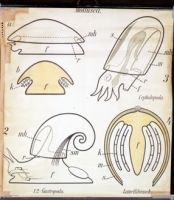 软体动物门(化石) 软体动物门(化石)
軟體動物門(化石)
軟體動物門是無脊椎動物中第二大門,既有水生也有陸生種類,以海生種類最為豐富,生活習性各異,有很多可作為指示沉積環境的指相化石。在世界和中國寒武係的最底部,已有單板綱和其他軟體動物化石出現,在越新的地層中越占重要位置。除分類演化的研究外,還有標示地層時代的作用,如中生界的不少菊石成為洲際範圍內劃分、對比地層的帶化石,有些可用以瞭解古水域溫度、含????度等;蝸牛化石能反映第四紀氣候環境,也可用於進行碳同位素年齡的測定以及生物韻律的研究,以瞭解古代地球的自轉周期;第四紀的化石有時具考古學意義;某些化石如雙殼綱中固着蛤類屬種的分佈,有利於大陸漂移和板塊構造的研究。
概述 軟體動物各綱之間的差異較大,不易找到共同的構造特徵,衹能根據形態特徵的漸變、胚胎發生的近似以至演化史上的化石證據而互相聯繫,統一於軟體動物門內。軟體動物中除較原始的無板、單板和多板綱外,喙殼綱的單殼在背部中央對折為兩片,但兩者多少均有連接,並衹有一共同的生長原點。在較低級代表中其背部連接處還有鈣質殼片相連;在較高級代表中則發育一後部的喙殼。雙殼綱可能由最原始的喙殼綱演變而來,其背部連接處的鈣質殼轉化為角質的韌帶,頭部也更為退化。腹足綱的多數種類由單殼加深為近錐狀,動物體內臟團扭轉,殼體也旋轉成蠃旋形。掘足綱也可能由喙殼綱演變而來,其單殼於腹部包捲並愈合成為角錐狀外殼,包住伸長了的動物體。頭足綱在本門中最為發達特化,頭部極為發達,足轉為觸手、腕和漏鬥,外殼類殼體有直殼、弓殼、環殼和旋殼等型,內殼類殼體為軟體捲包,甚至殼體退化。
在化石中,本門的雙殼綱與腕足動物應予區別,笠帽狀的無鉸類腕足動物化石,如據肌痕、單殼或雙殼、有無肉莖孔隙與貝殼的物質成分,也可與本門單板綱、腹足綱等笠帽狀化石區分。節肢動物門的葉肢介化石殼為幾丁質和膜質,殼瓣生長帶上有各種細微殼飾,生長綫細而規則,無中斷、分叉、相交或尖滅現象,可與本門的雙殼綱化石區別。
大多數軟體動物棲息於淺海中,也見於潮間帶和深達萬餘米的深海中。雙殼類和腹足類能生活於淡水中,後者還有陸生種類。許多種類如雙殼綱的固着蛤類和頭足綱的鸚鵡蠃類,可作為溫暖海洋的標志,有些蝸牛類化石則反映陸地氣候。在北溫帶或近極區,淡水軟體動物秋鼕季鑽入泥中和遷入深水區;在幹旱地區和沙漠中,它們也鑽入泥中潛居,有些蝸牛類在沙漠中分泌粘液自封於岩隙中、埋於地下或緊附於樹幹及岩石上,一旦有雨,復蘇後饕餮大食。因此,腹足類和雙殼類具有較大的指示古地理環境的價值。
除掘足類外,其他軟體動物在寒武係中已有化石發現,其中單板綱和腹足綱化石在中國下寒武統中也有發現並已出現分異,似說明它們在寒武紀之前可能已發生。
無板綱 其印痕化石是否存在於寒武係或其下地層中尚難以肯定。笠帽狀並具兩側對稱而分散的背肌痕類(tergomyan)單板綱動物,兼有現生的和下寒武統的化石代表,寒武係以後地層中也出現了殼體較高、稍旋並具環狀或近環狀肌痕的環肌痕類 (cyclomyan)單板綱化石。後者是否進步種類,仍待研究。
多板綱 化石見於上寒武統。古生代化石大多數板殼間的疊覆較弱,這樣的多板類尚有一屬存留至今;而中生代的多板綱化石較多,對它們的演化還無詳細瞭解。從多板類軀體的伸長、背腹面近扁平和多殼疊覆,有人認為多板綱可能適應於淺水潮間帶崎嶇不平水底的捲麯生活。無板類、單板類和多板類均較原始,這3類都具有擔輪幼蟲期而無面盤幼蟲期,可能是從 |
|
| 身體柔軟,一般左右對稱,不分節可分為頭、足、內臟團三個部分,體被外套膜,常常分泌有貝殼。次生體腔,後腎管,蠃旋式卵裂,個體發育中具有擔輪幼蟲。鰓或肺呼吸。分佈廣泛。目前已記載130000種,是動物界中的第二大門,可分7個綱:單板綱Monoplacophora、無板綱Merostomata(新月貝)、多板綱Polyplacophora(石鱉)、腹足綱Gastropoda(蠃類和蝸牛)、掘足綱Scaphopoda(角貝)、瓣鰓綱Lamellibranchia(貝類)、頭足綱Lamellibranchia(鸚鵡蠃、烏賊、柔魚、章魚)。 |
|
- lat.: molluscas
|
|
| 軟體動物 |
|
| 生物 | 動物 | 動物學 | 生物學術語 | 生物學 | 後鰓亞綱 | 無楯目 | 腹足綱 | | 貝類動物 | 中腹足目 | 寶蠃科 | 海洋動物 | 百科大全 | 雙殼綱 | 簾蛤目 | 馬珂蛤科 | | 雙殼鋼 | 鶯蛤目 | 海扇蛤科 | 簾蛤科 | 貝類物動 | 軟體動物 | 新腹足目 | 榧蠃科 | | 更多結果... |
|
|
|
|
 雙殼綱 雙殼綱 |  頭足綱 頭足綱 |  腹足綱 腹足綱 |  掘足綱 掘足綱 |  多板綱 多板綱 |  喙殼綱 喙殼綱 |  單板綱 單板綱 |  軟舌蠃綱 軟舌蠃綱 |  無板綱 無板綱 |  竹節石綱 竹節石綱 | |
|